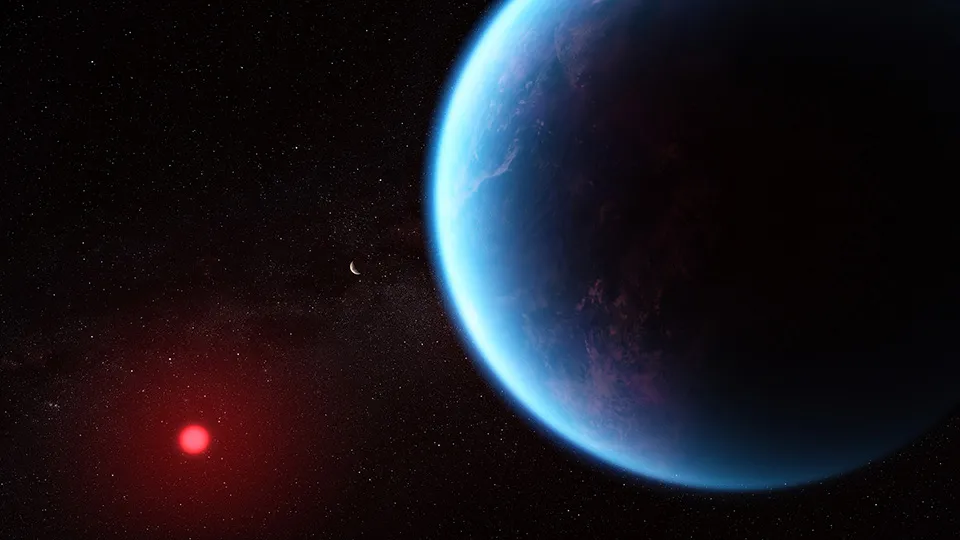This article discusses the first-ever discovery of Dimethyl Sulfide (DMS) in the atmosphere of K2-18b, an exoplanet located 124 light-years away from Earth. It discusses the importance of DMS as a biomarker, the tools and methods used to detect it, and the possible implications for extraterrestrial life. The discovery challenges conventional ideas of habitable conditions and sets the stage for future space exploration.
What is DMS?
DMS (Dimethyl Sulfide) is a gaseous compound produced by biological activity, primarily by phytoplankton in Earth’s oceans. Its presence in an atmosphere suggests the existence of life.
Why DMS is Important:
Unique Origin – DMS is only produced by living organisms, unlike gases such as oxygen or methane, which can also come from non-biological processes.
Strong Biomarker – Detecting DMS in the atmosphere of another planet could strongly indicate life because few to no non-biological things produce it.
Complement to Other Biomarkers – DMS, when found alongside gases like oxygen or methane, strengthens the case for biological activity since it reduces ambiguity about non-living sources.
When and how it was discovered, methods and resources used:
DMS was discovered on K2-18b, an exoplanet 124 lightyears from earth, using the James Webb Space Telescope (JWST). It also confirmed that K2-18b was an exo-planet generating the carbon-bearing compounds, CH4 and CO2. The findings of Webb confirmed K2-18b’s capacity for human life with a hydrogen-rich atmosphere and oceanized surface.
The tools the JWST used to investigate the atmosphere and which gases/molecules were found:
The cameras used were NIRSpec and NIRISS to investigate the atmosphere. Methane (CH4), carbon dioxide (CO2), and DMS were found, which are all indicative of possible life.
Important scientists and institutions that contributed to the finding:
The study was led by Nikku Madhusudhan, an astronomer at the University of Cambridge, who led the study that analyzed atmospheric data from the exoplanet K2-18b, which helped in identifying DMS. Important knowledge related to the planetary atmospheres was discovered by the Carnegie Institution for Science, and the Space Science Institute further helped in modeling and understanding spectral data to improve overall insight into the findings.
When the discovery occurred and the scientific community’s reaction timeline:
- 2015: K2-18b discovered by Kepler Space Telescope.
- 2019: K2-18b’s atmosphere was found to contain water vapor by the Hubble Space Telescope.
- 2023: JWST discovered methane, carbon dioxide, and DMS.
Scientist’s thoughts upon discovery
The scientific community was excited with the potential of extraterrestrial life yet attempting to minimize expectations. There’s much more we don’t understand before we can determine if life beyond our Earth is occurring.
How this connects to Earth and future research
Other gases that were detected over time are in Earth’s atmosphere as well. For example, methane, to which DMS is a weak, tenuous biomarker. Therefore, if DMS is found on K2-18b, it’s not out of the question to think it’s found somewhere else in the universe with the factors to create and support life. Therefore, the fact that DMS exists in the atmosphere here on Earth as a byproduct of such biological activity is just one more link between the two worlds of this universe, although separate and distanced. In addition, it expands the potential of where astronomers could look back on in time to have had or still have inhabited life. It prompts questioning of further investigations on K2-18b and planets like it.
How this discovery impacts our understanding of life elsewhere in the universe
The discovery of DMS in the atmosphere of K2-18b makes us rethink what we used to see as an “ideal” atmosphere for life. It proves that life could thrive in places that we previously thought were unsuitable. For instance, DMS, a compound related to living things on Earth, could mean that atmospheres with a lot of hydrogen or other gases, like K2-18b, might also have life. It broadens our concepts of what makes a place livable beyond just Earth-like conditions. Ideal conditions could occur in varying states over time, so scientists must not limit their search for life to exoplanets with smaller atmospheres or those that maintain a constant temperature.
Possible budgetary change and mission focus for further space research
This could start a budget change and mission possibility in the future for exoplanets that appear to have signs of life. For instance, future missions may focus on these water worlds with thick hydrogen atmospheres as their signs of life.
There are plans for future missions to study K2-18b and other similar planets outside our solar system. These missions may be equipped with advanced tools that will look closely at K2-18b. They will try to confirm if there is life and also check out other planets that are like it.
Spectra of K2-18b
Observations with Webb’s NIRISS (Near-Infrared Imager and Slitless Spectrograph) and NIRSpec (Near-Infrared Spectrograph) reveal a lot of methane and carbon dioxide in the atmosphere of the exoplanet, along with a possible indication of DMS. Methane and carbon dioxide are present, but ammonia is not, in support of the hypothesis that there could be an ocean of water under a hydrogen-rich atmosphere on K2-18b. K2-18b is 8.6 times heavier than Earth. It orbits around the cool dwarf star K2-18 in a zone where life could exist. It is only 120 light-years away from Earth.
Looking Ahead
The detection of DMS is weaker and requires more confirmation. Upcoming observations using the Webb telescope will have the capability of confirming the presence of DMS in the atmosphere of K2-18b at significant levels. K2-18b lies within the habitable zone and hosts carbon-bearing molecules, but that does not necessarily set conditions for life on the planet. Due to the large size of this planet, it most likely has a thick layer of high-pressure ice inside, similar to Neptune, but with a thinner atmosphere full of hydrogen and an ocean on its surface.
Final Thought
Characterizing the atmospheres of exoplanets, like K2-18b, involves identifying their gases and physical conditions. This area of research is extremely active in astronomy. The team’s results, accepted for publication in The Astrophysical Journal Letters, are a promising step toward a deeper understanding of the potential for life on exoplanets.
Sources:
https://www.nasa.gov/universe/webb-discovers-methane-carbon-dioxide-in-atmosphere-of-k2-18-b/
https://youtube.com/shorts/i4gIVEJ_ocI?si=rRUXMaDry0uky9UV
ChatGPT. OpenAI, 2025.












Belinda Santiago • Jan 18, 2025 at 12:50 PM
Pablo, I enjoyed reading this informative article. It is scary but promising to know that there is potential for life on exoplanets. I would like to have a more in-depth conversation with you about this topic.